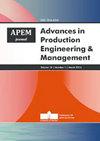Latent class analysis for identification of occupational accident casualty profiles in the selected Polish manufacturing sector
IF 2.8
3区 工程技术
Q2 ENGINEERING, MANUFACTURING
引用次数: 1
Abstract
The objective of the analysis is identifying profiles of occupational accident casualties as regards production companies to provide the necessary knowledge to facilitate the preparation and management of a safe work environment. Qualitative data characterizing employees injured in accidents registered in Polish wood processing plants over a period of 10 years were the subject of the research. The latent class analysis (LCA) method was employed in the investigation. This statistical modelling technique, based on the values of selected indicators (observed variables) divides the data set into separate groups, called latent classes, which enable the definition of patterns. A procedure which supports the decision as regards the number of classes was presented. The procedure considers the quality of the LCA model and the distinguishability of the classes. Moreover, a method of assessing the importance of indicators in the patterns description was proposed. Seven latent classes were obtained and illustrated by the heat map, which enabled the profiles identification. They were labelled as follows: very serious, serious, moderate, minor (three latent classes), slight. Some recommendations were made regarding the circumstances of occupational accidents with the most severe consequences for the casualties.潜在类分析,以确定职业事故伤亡概况在选定的波兰制造业
分析的目的是查明生产公司的职业意外伤亡情况,以提供必要的知识,促进安全工作环境的准备和管理。研究的主题是10年来波兰木材加工厂登记的事故中受伤雇员的定性数据。采用潜类分析(LCA)方法进行调查。这种统计建模技术基于所选指标(观察到的变量)的值,将数据集划分为称为潜在类的单独组,从而能够定义模式。提出了一个支持关于类别数目的决定的程序。该过程考虑了LCA模型的质量和类的可区分性。此外,提出了一种评价指标在模式描述中的重要性的方法。得到了7个潜在类别,并通过热图进行了说明,从而实现了剖面的识别。它们被标记为:非常严重、严重、中等、轻微(三个潜在等级)、轻微。就对伤亡造成最严重后果的职业事故的情况提出了一些建议。
本文章由计算机程序翻译,如有差异,请以英文原文为准。
求助全文
约1分钟内获得全文
求助全文
来源期刊

Advances in Production Engineering & Management
ENGINEERING, MANUFACTURINGMATERIALS SCIENC-MATERIALS SCIENCE, MULTIDISCIPLINARY
CiteScore
5.90
自引率
22.20%
发文量
19
期刊介绍:
Advances in Production Engineering & Management (APEM journal) is an interdisciplinary international academic journal published quarterly. The main goal of the APEM journal is to present original, high quality, theoretical and application-oriented research developments in all areas of production engineering and production management to a broad audience of academics and practitioners. In order to bridge the gap between theory and practice, applications based on advanced theory and case studies are particularly welcome. For theoretical papers, their originality and research contributions are the main factors in the evaluation process. General approaches, formalisms, algorithms or techniques should be illustrated with significant applications that demonstrate their applicability to real-world problems. Please note the APEM journal is not intended especially for studying problems in the finance, economics, business, and bank sectors even though the methodology in the paper is quality/project management oriented. Therefore, the papers should include a substantial level of engineering issues in the field of manufacturing engineering.
 求助内容:
求助内容: 应助结果提醒方式:
应助结果提醒方式:


